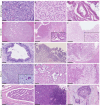Integrative Analysis of Intrahepatic Cholangiocarcinoma Subtypes for Improved Patient Stratification: Clinical, Pathological, and Radiological Considerations
- PMID: 35804931
- PMCID: PMC9264781
- DOI: 10.3390/cancers14133156
Integrative Analysis of Intrahepatic Cholangiocarcinoma Subtypes for Improved Patient Stratification: Clinical, Pathological, and Radiological Considerations
Abstract
Intrahepatic cholangiocarcinomas (iCCAs) may be subdivided into large and small duct types that differ in etiology, molecular alterations, therapy, and prognosis. Therefore, the optimal iCCA subtyping is crucial for the best possible patient outcome. In our study, we analyzed 148 small and 84 large duct iCCAs regarding their clinical, radiological, histological, and immunohistochemical features. Only 8% of small duct iCCAs, but 27% of large duct iCCAs, presented with initial jaundice. Ductal tumor growth pattern and biliary obstruction were significant radiological findings in 33% and 48% of large duct iCCAs, respectively. Biliary epithelial neoplasia and intraductal papillary neoplasms of the bile duct were detected exclusively in large duct type iCCAs. Other distinctive histological features were mucin formation and periductal-infiltrating growth pattern. Immunohistochemical staining against CK20, CA19-9, EMA, CD56, N-cadherin, and CRP could help distinguish between the subtypes. To summarize, correct subtyping of iCCA requires an interplay of several factors. While the diagnosis of a precursor lesion, evidence of mucin, or a periductal-infiltrating growth pattern indicates the diagnosis of a large duct type, in their absence, several other criteria of diagnosis need to be combined.
Keywords: adenocarcinoma; diagnostic imaging; large duct type; liver cancer; small duct type; subtyping.
Conflict of interest statement
The authors declare no conflict of interest.
Figures




Similar articles
-
Morphologic and immunohistochemical characterization of small and large duct cholangiocarcinomas in a Western cohort: A panel of pCEA, CRP, N-cadherin, and albumin in situ hybridization aids in subclassification.Ann Diagn Pathol. 2025 Apr;75:152437. doi: 10.1016/j.anndiagpath.2025.152437. Epub 2025 Jan 10. Ann Diagn Pathol. 2025. PMID: 39832462
-
Nestin may be a candidate marker for differential diagnosis between small duct type and large duct type intrahepatic cholangiocarcinomas.Pathol Res Pract. 2024 Jan;253:155061. doi: 10.1016/j.prp.2023.155061. Epub 2023 Dec 22. Pathol Res Pract. 2024. PMID: 38154357
-
Bile duct adenoma may be a precursor lesion of small duct type intrahepatic cholangiocarcinoma.Histopathology. 2021 Jan;78(2):310-320. doi: 10.1111/his.14222. Epub 2020 Sep 15. Histopathology. 2021. PMID: 33405289
-
Pathological aspects of mucinous cholangiocarcinoma: A single-center experience and systematic review.Pathol Int. 2020 Sep;70(9):661-670. doi: 10.1111/pin.12983. Epub 2020 Jul 7. Pathol Int. 2020. PMID: 32638458
-
Recent Advances in Pathology of Intrahepatic Cholangiocarcinoma.Cancers (Basel). 2024 Apr 17;16(8):1537. doi: 10.3390/cancers16081537. Cancers (Basel). 2024. PMID: 38672619 Free PMC article. Review.
Cited by
-
Overexpression of KMT9α is associated with poor outcome in cholangiocarcinoma patients.J Cancer Res Clin Oncol. 2025 May 13;151(5):161. doi: 10.1007/s00432-025-06214-w. J Cancer Res Clin Oncol. 2025. PMID: 40355770 Free PMC article.
-
Surgical interpretation of the WHO subclassification of intrahepatic cholangiocarcinoma: a narrative review.Surg Today. 2025 Jan;55(1):1-9. doi: 10.1007/s00595-024-02825-x. Epub 2024 Apr 2. Surg Today. 2025. PMID: 38563999 Review.
-
Small duct and large duct type intrahepatic cholangiocarcinoma reveal distinct patterns of immune signatures.J Cancer Res Clin Oncol. 2024 Jul 22;150(7):357. doi: 10.1007/s00432-024-05888-y. J Cancer Res Clin Oncol. 2024. PMID: 39034327 Free PMC article.
-
[N-cadherin as a novel diagnostic marker : Differentiation of primary liver tumours from metastases of an extrahepatic primary tumour].Pathologie (Heidelb). 2025 Jun 25. doi: 10.1007/s00292-025-01440-y. Online ahead of print. Pathologie (Heidelb). 2025. PMID: 40560379 Review. German.
References
-
- Lamarca A., Palmer D.H., Wasan H.S., Ross P.J., Ma Y.T., Arora A., Falk S., Gillmore R., Wadsley J., Patel K. ABC-06|A randomised phase III, multi-centre, open-label study of active symptom control (ASC) alone or ASC with oxaliplatin/5-FU chemotherapy (ASC + mFOLFOX) for patients (pts) with locally advanced/metastatic biliary tract cancers (ABC) previously-treated with cisplatin/gemcitabine (CisGem) chemotherapy. J. Clin. Oncol. 2019;37
Grants and funding
LinkOut - more resources
Full Text Sources
Research Materials
Miscellaneous

